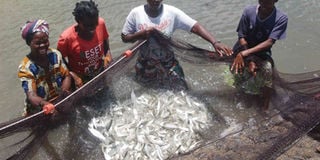Fish farming offers lifeline to Kilifi group

Members of "Umoja Mari culture self help group" (an integrated project) fishing in one of the ponds as they sample fish and prawns at Kibokoni in Kilifi creek. PHOTO | GEORGE KIKAMI |
What you need to know:
- At one of the 13 ponds on the expansive beach, group chairman Michael Kea is keeping vigil to ward off predators — fish species that eat the fingerlings.
- Joseph Tunje, an assistant Lecturer in the Department of Environmental Sciences at Pwani University, says they started with a Sh6 million grant from the commission for science.
At Kibokoni area along the Kilifi creek, Peris Chengo is feeding a shoal of milk fish in a pond after a heavy downpour.
On her weekly shift, she moves from pond to pond to feed the juvenile fish.
Peris is a member of the Kilifi Mariculture Umoja Self Help Group, which was started by Pwani University, the National Commission for Science, Technology and Innovation, the Kenya Marine and Fisheries Research Institute and the fisheries department.
Welcome to mariculture, a specialised branch of aquaculture that deals with cultivation of marine species for food and other products in the open ocean, an enclosed section of the ocean or in tanks and ponds filled with sea water.
The concept is growing worldwide at a rate of five-to-seven per cent annually. It offers protein-rich food and acts as a source of income to the local people. The self-help group has 59 women and 16 men.
At one of the 13 ponds on the expansive beach, group chairman Michael Kea is keeping vigil to ward off predators — fish species that eat the fingerlings.
FINGERLINGS SCARCITY
Chengo, a mother of six, says she is now able to educate her son besides acquiring skills in fisheries management.
“I have earned Sh20,000 from pond construction and about Sh5,000 from the first harvest,” she says. “The amount helped me pay Sh18,000 fees for my son’s enrolment into Form One. I used the rest to buy uniform.”
Their eight ponds, she says, are stocked with between 360 and 4,500 milk fish which will mature after six months. At maturity, the fishes weigh at least 300 grammes.
“Our production in 2012 weighed 15 kilogrammes, 112 kilogrammes in 2013 and 80 kilogrammes in 2014. Prawn production at the experimental stage in 2011, 2012 and 2013 was 200, 28 and 50 kilogrammes, respectively. A kilo was fetching Sh500,” she says.
A scarcity of fingerlings and at times, hot weather, is however harming the health of the fish.
Their current stock was bought from Makongeni Women Group in South Coast at Sh10 per fingerling.
One of heaviest investments is pond construction. Kea says they set up the small ponds cost Sh100,000 each and Sh1 million for the large ones.
To supplement their earnings, the group also plants trees.
“We also conserve mangrove by planting seeds in a nursery. We later sell the seedlings and members take loans from the proceeds,” he says. So far, the group has sold 6,000 seedlings at Sh15.
Joseph Tunje, an assistant Lecturer in the Department of Environmental Sciences at Pwani University, says they started with a Sh6 million grant from the commission for science.
FIGHT POVERTY
There were two components — milk fish farming and a 20,000 mangrove seedlings restoration on the mud flat area of the creek. “The idea was to impart skills to the small-scale mariculture farmers and convert to a commercial venture.”
The farming is a success but members lack serious commitment and monitoring is poor due to lack of understanding of scientific procedures.
“It is hard for members to measure the salinity of water after lessons were carried out due to their levels of education,” he says.
Dr David Mirera, a scientist at Kenya Marine Fisheries and Research Institute, says their support is to improve production to commercial levels through pond construction and stocking them.
He says harvest from the pond is estimated to be 900kg of milk fish and 100kg of prawns.
Dr Mirera says the milk fish species is unique for the coastal waters and they chose to farm it because it is consumed in the area.
READY MARKET
This species is also easy to get in mangrove areas of the sea and can tolerate a wide range of environmental factors, including salinity.
“They feed on sea plants and are easy for the people to keep before adopting other fish species that demand a lot of care,” he says.
The future looks bright, with a ready market in Mombasa, Malindi and Kilifi counties.
“With a production of a tonne from each pond in a year, harvested fish will not go beyond farm gate,” he says.





